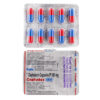Pharmaceutical Gabapentin 300mg x 10 Capsules
£9.99
Gabapentin 300mg x 10
Pharmaceutical Gabapentin 300mg Capsules
Classification
- Active substance: Gabapentin
- Form: 300mg capsules
- Active half-life: 5-7 hours
- Acne: Not associated
- Water retention: No
- HBR: No
- Hepatotoxicity: Low
- Aromatization: No
Product Description for Gabapentin 300mg Capsules
Gabapentin 300mg capsules are designed to provide effective relief from neuropathic pain and as an adjunct treatment for epilepsy. This pharmaceutical product is well-regarded for its efficacy and safety profile, making it a reliable choice for managing chronic pain and seizure disorders. Each capsule contains 300mg of gabapentin, a medication that works by stabilizing electrical activity in the brain and influencing the way nerves send messages to your brain. Manufactured under stringent quality controls, these capsules ensure consistency and purity, delivering the intended therapeutic effects for users seeking relief from neuropathic pain or support in managing epilepsy.
How Gabapentin 300mg Capsules Work and Their Function
Gabapentin works by modulating the activity of neurotransmitters and stabilizing nerve activity in the brain. Though the exact mechanism is not fully understood, it is believed to bind to a specific subunit of voltage-gated calcium channels, which inhibits excitatory neurotransmitter release. This action helps reduce neuropathic pain by calming overactive nerves and provides an anticonvulsant effect in patients with epilepsy. By dampening the excessive electrical activity in the brain, gabapentin helps to prevent seizures and provides relief from chronic nerve pain, thereby improving the quality of life for individuals with these conditions.
The Suggested Dosage for Gabapentin 300mg Capsules
The recommended dosage of Gabapentin 300mg capsules varies based on the condition being treated and the patient’s response to therapy. For neuropathic pain, a typical starting dose is 300mg taken once on the first day, 300mg twice on the second day, and 300mg three times on the third day. The dose can then be increased as needed up to a maximum of 3600mg per day, divided into three doses. For epilepsy, the starting dose is usually 300mg three times a day, which may be increased based on clinical response. Always follow the prescribing doctor’s instructions and never adjust the dose without medical advice.
Benefits of Taking Gabapentin 300mg Capsules
Gabapentin 300mg capsules offer significant benefits for individuals suffering from neuropathic pain and epilepsy. For neuropathic pain, gabapentin provides substantial relief, reducing pain intensity and improving overall functionality and quality of life. Patients with epilepsy benefit from gabapentin’s anticonvulsant properties, which help in reducing the frequency and severity of seizures. The medication is well-tolerated by most patients, and its flexible dosing allows for tailored treatment plans to suit individual needs. Additionally, gabapentin does not induce drug dependence, making it a safe long-term option for managing chronic conditions.
Effects and Precautions of Using Gabapentin 300mg Capsules
While gabapentin is generally well-tolerated, it is essential to be aware of potential side effects and precautions. Common side effects include dizziness, fatigue, and peripheral oedema. Some patients may also experience dry mouth, weight gain, and blurred vision. It is important to avoid abrupt discontinuation of the medication, as this can lead to withdrawal symptoms and potential seizure recurrence in epileptic patients. Gradual dose reduction under medical supervision is recommended. Patients should also inform their healthcare provider of any other medications they are taking to avoid potential drug interactions. Regular follow-up appointments are crucial to monitor effectiveness and adjust dosage if necessary.
Mechanism of Action of Gabapentin
Gabapentin exerts its effects by binding to the alpha-2-delta subunit of voltage-gated calcium channels in the central nervous system. This binding inhibits the release of excitatory neurotransmitters, which are chemicals responsible for transmitting signals between nerve cells. By modulating these signals, gabapentin helps to stabilize nerve activity and reduce hyperexcitability, which is a key factor in conditions like neuropathic pain and epilepsy. This mechanism not only alleviates pain but also prevents the abnormal electrical activity that leads to seizures, making gabapentin a versatile and effective treatment option.
Clinical Uses of Gabapentin
Gabapentin is primarily used for the management of neuropathic pain and as an adjunctive therapy in the treatment of epilepsy. It is particularly effective in treating conditions such as diabetic neuropathy, postherpetic neuralgia, and fibromyalgia, where it helps to reduce chronic pain that is often resistant to other treatments. In epilepsy, gabapentin is used as an add-on therapy for partial seizures, providing additional seizure control in patients who do not respond adequately to other antiepileptic drugs. Gabapentin’s versatility extends to off-label uses as well, including the treatment of restless legs syndrome and anxiety disorders.
Potential Side Effects of Gabapentin
While gabapentin is generally well-tolerated, it is associated with some potential side effects. Common side effects include dizziness, drowsiness, and peripheral oedema. Some patients may experience dry mouth, weight gain, and gastrointestinal issues such as nausea and vomiting. In rare cases, more severe side effects like mood changes, depression, or suicidal thoughts may occur. It is important to monitor for these side effects and report any unusual symptoms to a healthcare provider promptly. Regular follow-up visits are recommended to ensure the medication is working effectively and to make any necessary adjustments to the dosage.
Gabapentin for Neuropathic Pain Management
Gabapentin is a cornerstone treatment for neuropathic pain, providing relief for conditions such as diabetic neuropathy, postherpetic neuralgia, and fibromyalgia. Its ability to modulate nerve activity helps to alleviate the chronic pain that arises from damaged or dysfunctional nerves. Patients often experience significant reductions in pain intensity and improvements in overall quality of life. Gabapentin’s effectiveness in managing neuropathic pain makes it a valuable option for individuals who have not found relief with other treatments. By targeting the underlying nerve dysfunction, gabapentin helps to provide sustained pain relief and improve daily functioning.
Gabapentin in Epilepsy Treatment
In the treatment of epilepsy, gabapentin is used as an adjunctive therapy for partial seizures. Its anticonvulsant properties help to reduce the frequency and severity of seizures, providing better overall control for patients who do not respond adequately to other antiepileptic drugs. Gabapentin’s relatively mild side effect profile and lack of significant drug interactions make it a suitable option for long-term management of epilepsy. Patients on gabapentin therapy often report improved seizure control and enhanced quality of life, making it a valuable addition to their treatment regimen.
Patient Experiences with Gabapentin
Patients taking gabapentin for neuropathic pain or epilepsy often report positive experiences, noting significant reductions in pain and seizure frequency. Many appreciate the medication’s ability to provide relief where other treatments have failed, allowing them to regain function and improve their daily lives. While some patients experience mild side effects such as dizziness or drowsiness, these are generally manageable and tend to diminish over time. The overall patient satisfaction with gabapentin is high, with many finding it to be an essential component of their pain management or seizure control strategy.
How to Take Gabapentin Effectively
To take gabapentin effectively, it is important to follow the prescribed dosage and administration guidelines closely. Gabapentin is typically taken three times a day, with or without food. Starting with a low dose and gradually increasing as directed helps to minimize side effects and allows the body to adjust to the medication. It is crucial not to abruptly discontinue gabapentin, as this can lead to withdrawal symptoms and potential seizure recurrence. Gradual tapering under medical supervision is recommended. Consistent follow-up with a healthcare provider ensures the medication is working effectively and allows for any necessary adjustments to the dosage.
Comparing Gabapentin with Other Medications
Gabapentin is often compared to other medications used for neuropathic pain and epilepsy, such as pregabalin (Lyrica) and traditional antiepileptic drugs. While pregabalin is similar to gabapentin in its mechanism of action, it is often preferred for its quicker onset of action and better bioavailability. However, gabapentin is generally more cost-effective and has a longer track record of use. In epilepsy, gabapentin is used as an adjunctive therapy rather than a primary treatment, complementing other antiepileptic drugs to provide better seizure control. The choice between gabapentin and other medications depends on individual patient needs, response to treatment, and side effect profiles.
Long-term Use of Gabapentin: What to Expect
Long-term use of gabapentin can lead to sustained pain relief and improved seizure control. Patients using gabapentin for extended periods generally experience consistent benefits, with manageable side effects. Regular monitoring by a healthcare provider is important to ensure continued effectiveness and to adjust dosages as needed. Long-term users should be aware of the potential for tolerance, where the body becomes accustomed to the medication, potentially requiring dosage adjustments. Overall, gabapentin remains a reliable option for long-term management of neuropathic pain and epilepsy, providing lasting relief and improved quality of life.
Gabapentin and Its Impact on Quality of Life
Gabapentin significantly impacts the quality of life for individuals with chronic neuropathic pain or epilepsy. By providing effective pain relief and seizure control, gabapentin helps patients regain function, improve mobility, and reduce the psychological burden of chronic conditions. Many patients report enhanced daily functioning, better sleep, and increased participation in social and physical activities. The ability to manage pain and prevent seizures allows for a more active and fulfilling life. Gabapentin’s overall positive impact on quality of life makes it a valuable treatment option for those struggling with these debilitating conditions.
Monitoring and Adjusting Gabapentin Dosage
Regular monitoring and adjusting the dosage of gabapentin are essential for optimal treatment outcomes. Healthcare providers will typically start patients on a low dose and gradually increase it based on response and tolerance. Regular follow-up visits allow for assessment of the medication’s effectiveness and any side effects experienced. Dosage adjustments are made as necessary to maintain pain relief or seizure control while minimizing adverse effects. Patients should communicate openly with their healthcare provider about their symptoms and any changes they experience, ensuring the treatment plan remains effective and tailored to their needs.
Gabapentin in Combination Therapy
Gabapentin is often used in combination therapy to enhance its effectiveness in treating neuropathic pain and epilepsy. When combined with other medications, such as antidepressants, opioids, or other antiepileptic drugs, gabapentin can provide synergistic effects, leading to better overall outcomes. For instance, in neuropathic pain management, combining gabapentin with opioids can provide superior pain relief compared to either medication alone. In epilepsy, gabapentin can be added to existing antiepileptic regimens to achieve better seizure control. Combination therapy should be carefully managed by a healthcare provider to avoid potential drug interactions and optimize therapeutic benefits.
Gabapentin and Mental Health
Gabapentin has shown promise in addressing certain mental health conditions, particularly anxiety disorders. Its ability to modulate neurotransmitter activity can help reduce symptoms of anxiety, providing a calming effect. Some patients with generalized anxiety disorder or social anxiety disorder may find gabapentin to be a helpful adjunct to their treatment plan. Additionally, gabapentin’s mood-stabilizing properties can benefit individuals with bipolar disorder, especially those experiencing mixed episodes. While not a first-line treatment for mental health conditions, gabapentin can be a valuable addition to a comprehensive treatment strategy under the guidance of a healthcare provider.
Safety Profile of Gabapentin
Gabapentin has a favourable safety profile, making it a well-tolerated option for long-term use in managing neuropathic pain and epilepsy. Common side effects include dizziness, drowsiness, and peripheral oedema, which are typically mild and manageable. Serious adverse effects are rare but may include mood changes, depression, or suicidal thoughts. Gabapentin is not associated with significant drug interactions, making it a versatile choice for combination therapy. It is also not hepatotoxic and does not induce drug dependence, further enhancing its safety for long-term use. Regular monitoring and adherence to prescribed dosages are essential to maintain its safety and efficacy.
Gabapentin: What You Need to Know
Gabapentin is a versatile medication used primarily for neuropathic pain and as an adjunctive therapy in epilepsy. Its mechanism of action involves modulating neurotransmitter activity to stabilize nerve function and prevent seizures. With a favourable safety profile and manageable side effects, gabapentin is suitable for long-term use. Patients should follow prescribed dosages closely, attend regular follow-up appointments, and communicate any side effects or changes in symptoms to their healthcare provider. Gabapentin offers significant benefits in pain management and seizure control, improving overall quality of life for many individuals.
Purchasing Gabapentin 300mg Capsules from Steroid Sanctuary
When purchasing Gabapentin 300mg capsules, choosing a reputable source like Steroid Sanctuary ensures you receive high-quality, authentic medication. Steroid Sanctuary is committed to providing top-grade pharmaceutical products, sourced from reliable manufacturers. Their user-friendly website and secure ordering process make purchasing easy and convenient. Additionally, Steroid Sanctuary offers valuable information and support, helping you make informed decisions and achieve your health goals safely and effectively. With Steroid Sanctuary, you can trust in the quality and authenticity of the products you receive, ensuring the best possible outcomes for your treatment.
Related products
PCT Products
Injectable Steroids
Injectable Steroids
Oral Steroids
Oral Steroids
Injectable Steroids
Oral Steroids
Injectable Steroids















